SAME DAY AIR SOLUTIONS
Air Charter Aircraft
When dealing with time-sensitive shipping needs, having the right air freight logistics partner makes all the difference. Get a closer look at the aircraft we use for air charter services.
Key Advantages
Dedicated aircraft charters ensuring your shipment receives priority without conflicting cargo.
Round-the-clock, year-round availability to meet your urgent air freight needs anytime.
Exceptional, platinum-standard service and prompt scheduling for your air charter shipment.
Real-time, in-flight tracking for precise updates on delivery progress.
Trust SameDayAir.com to match your shipment with the ideal aircraft. Our specialized, concierge-style customer support and shipping flexibility ensure your air charter cargo reaches its destination promptly, exactly when you need it.
The Aircraft We Use
Explore our selection of charter aircraft, carefully selected to provide maximum flexibility for your shipments. Regardless of your urgent air cargo needs we offer the perfect aircraft to meet your specific requirements.
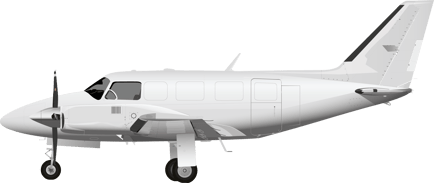
PIPER PA-31 | 33FT
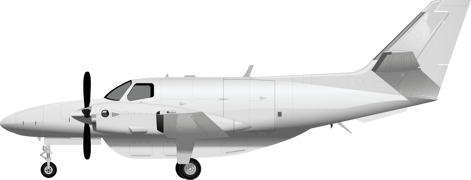
CESSNA 406 CARAVAN II | 39FT

PILATUS PC-12 | 49FT

EMBRAER EMB-110 | 50FT

DASSAULT FALCON 20 | 56FT

FAIRCHILD METRO II | 59FT

FAIRCHILD METRO III | 59FT

SHORTS SD 360 | 71FT

ANTONOV An-26 | 78FT

CONVAIR CV-580 | 82FT

MCDONNELL DOUGLAS DC-9 15F | 104FT

ANTONOV An-12 | 109FT

BOEING 737-300F | 110FT
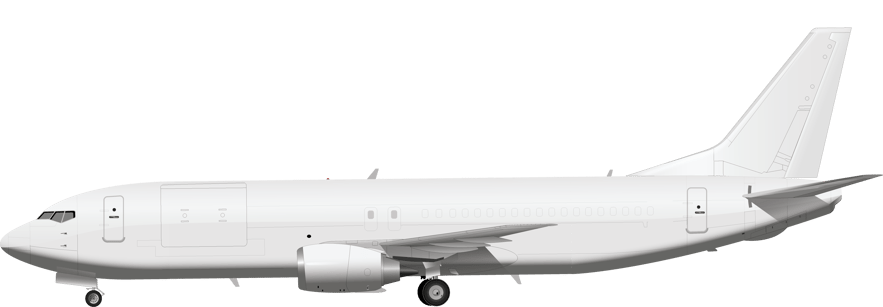
BOEING 737-400F | 120FT

MCDONNELL DOUGLAS DC-8 71 73F | 151FT

BOEING 727-200F | 153FT

BOEING 767-200F | 153FT

AIRBUS A300-600F | 177FT

MCDONNELL DOUGLAS DC-10F | 182FT

BOEING 777-200F | 209FT

ANTONOV An-124 | 226FT

BOEING 747 | 232FT
Your Air Charter Shipping Partner
Our expert logistics team works diligently behind the scenes, ensuring each shipment reaches its final destination on time and in perfect condition.
We provide rapid, reliable ground and air transport services tailored specifically for B2B clients throughout the U.S., Canada, and Mexico.
Contact us now—we're ready to handle your urgent shipping needs. I or another team member will guide you through every step.

Cargo Aircraft Details & Interiors
Boeing 747-400F
Purpose‑built for transport of outsized loads to virtually any destination, the 747‑400F combines a wide‑body fuselage, nose‑hinged opening, large side cargo door, and integrated handling rollers to speed every phase of loading and unloading.

Top Down Cutaway
Main Deck (Top)
Lower Deck (Bottom)
Max Payload
Cubic ft: 24,115
Weight: 274,000
Side Cargo Doors
Main Deck Aft
Width: 134 in
Height: 120 in
Lower Deck Fore
& Aft
Width: 110 in
Height: 66 in
Nose Cargo Door
Width: 140 in
Height: 98 in

Range & Routes
With a nonstop reach of roughly 5,200 miles at maximum payload, the 747‑400F excels on coast‑to‑coast U.S. sectors and direct services linking American gateways to major world markets. Fewer refuelling stops mean shorter schedules and less cargo‑handling exposure.
A typical network ties leading U.S. cities to European and Asian cargo hubs—including Amsterdam, Frankfurt, Tokyo, Seoul, Shanghai, Hong Kong, Taipei, and Singapore.
Airport Requirements
As a heavyweight freighter, the 747‑400F requires runways that are both wide and structurally robust enough for nearly 400 tons at take‑off and landing.
Taxiway Width: Measuring 232 ft long with a 211 ft wingspan, the jet needs broad taxi lanes and ample clearance for turns.
Most primary cargo airports already accommodate the type; smaller regional fields may face limits.
Parking Apron Space: A generous stand is necessary to allow ground crews full access—particularly at the nose door.
Runway Requirements
Takeoff: Around 10,500 ft at MTOW, with altitude, temperature, or wind potentially adding distance—especially above 8,000 ft elevation where thinner air affects performance.
Landing: A baseline of 7,500 ft is required; wet or contaminated surfaces lengthen the stopping roll.
Crew
The standard cockpit complement is captain and first officer. SameDayAir.com can assign additional loadmasters or specialists to safeguard the freight and coordinate seamless door‑to‑door delivery.
KEY AIRCRAFT SPECIFICATIONS
Boeing 747-400F Specs
Length
232 ft
Wingspan
211 ft
Maximum Takeoff Weight
875,000 lbs
Maximum Payload
Approximately 274,000 lbs
Range
5,200 miles with a full payload
Cargo Volume
Approximately 24,000 cubic ft
Cruise Speed
570 miles/hour or Mach 0.85
Engines
Usually equipped with four high-thrust engines like the Pratt & Whitney PW4000, General Electric CF6, or Rolls-Royce RB211
Pilatus PC-12
A versatile single‑engine turboprop fitted with a generous rear cargo door, the PC‑12 is optimised for short‑ to medium‑range missions and renowned for rugged reliability at small or unimproved strips.

Top Down Cutaway
Main Deck
Side Cargo Door
Width: 53 in
Height: 52 in
Max Payload
Cubic Ft: 400
Weight: 2,400

Range & Routes
At full payload, the PC‑12 covers approximately 1,700 miles nonstop—perfect for domestic U.S. lanes and remote communities throughout the United States, Canada, and Mexico.
Airport Requirements
This light utility aircraft comfortably operates from paved runways or grass, gravel, and other unprepared surfaces.
Taxiway Width: Compact dimensions—49 ft long and a 54 ft wingspan—let it manoeuvre along narrow taxi routes.
Parking Apron Space: Only minimal ramp area is needed for servicing and cargo work.
Ground Handling: Freight is usually hand‑loaded or rolled up a simple ramp; forklifts can place pallets directly into the cabin when required, with no specialised gear necessary.
Fueling: Up to 400 gal can be uplifted via cans, pumps, or truck bowsers, depending on location and mission.
Power and Air Support: External power is seldom required, though a 28‑volt GPU can connect to the auxiliary port when the engine is shut down.
Runway Requirements
Takeoff: About 2,500 ft from a paved surface at MTOW, with density altitude and surface condition influencing the requirement—particularly over 8,000 ft elevation.
Landing: Standard distance is around 2,200 ft; wet, icy, or rough strips demand extra margin.
Crew
Certified for single‑pilot IFR operations, the PC‑12 can also be crewed by two pilots when mission parameters dictate. Additional logistics staff may accompany the flight to supervise cargo and ensure smooth end‑to‑end coordination.
KEY AIRCRAFT SPECIFICATIONS
Pilatus PC-12 Specs
Length
49 ft
Wingspan
54 ft
Maximum Takeoff Weight
10,400 lbs
Maximum Payload
Approximately 2,400 lbs
Range
Depends on the model. The minimum range is approximately 1,700 miles with a full payload including crew, fuel, and cargo
Cargo Volume
Approximately 400 cubic ft
Cruise Speed
330 miles/hour
Engines
Usually equipped with one Pratt & Whitney Canada PT6A-67P turboprop engine
Antonov An-124
The Antonov An-124 is a massive, purpose-built cargo aircraft featuring a unique nose-opening design and an extensive rear door to streamline loading and unloading operations. It is specifically engineered to accommodate the heaviest and largest cargo loads of any existing aircraft.

Top Down Cutaway
Main Deck
Cargo Cross Section
Width: 251 in
Height: 173 in
Max Payload
Cubic ft: 36,085
Weight: 264,554
Nose Cargo Door
Width: 251 in
Height: 173 in

Range & Routes
Due to its specialized cargo capabilities, the Antonov An-124 operates a diverse set of international routes tailored to specific cargo requirements. It possesses a maximum non-stop range of approximately 2,300 miles when fully loaded, ideally suited for transporting oversized shipments across the United States, Canada, Mexico, and key global markets.
Airport Requirements
Given its substantial dimensions and weight, the An-124 demands airports with infrastructure capable of accommodating such specifications. Airports must have runways engineered to withstand the aircraft’s maximum takeoff weight approaching 400 tons, including stresses incurred during critical takeoff and landing phases.
Taxiway Width: With an impressive length of 232 feet and a wingspan of 213 feet, the An-124 requires wide taxiways offering ample maneuvering space to handle its turning radius safely.
Major U.S. cargo hubs such as JFK, Miami, Philadelphia, Dallas/Fort Worth, LAX, and Moffett Field frequently support operations of the An-124, although smaller regional airports might face certain operational restrictions.
Parking Apron Space: The Antonov An-124 necessitates expansive parking apron areas to facilitate the efficient loading and unloading of cargo, as well as routine servicing. Clearance around its nose and rear cargo doors is essential to avoid interference from nearby obstacles.
Ground Handling: Loading and unloading cargo from the An-124 typically requires specialized equipment, including cranes, forklifts, and customized cargo loaders.
Fueling: The aircraft can be refueled using advanced high-pressure aviation fueling systems or pantograph fuel hydrant methods. Fuel capacity varies according to payload but can reach up to approximately 65,000 gallons.
Power and Air Support: Equipped with two onboard auxiliary power units, the An-124 may require additional external ground power units, particularly for operating its internal crane mechanisms.
Runway Requirements
Takeoff Runway Length: A fully loaded Antonov An-124 generally requires a minimum runway length of around 9,800 feet to safely attain takeoff speed. Runway length requirements can vary based on environmental factors such as altitude, wind, and temperature. Airports situated above 8,000 feet altitude typically need extended runway lengths due to reduced air density.
Landing Runway Length: At maximum payload, the An-124 generally requires a runway length of approximately 7,800 feet, although an absolute minimum of 3,000 feet is achievable in extraordinary circumstances due to the aircraft’s powerful thrust reversers. Conditions such as wet, icy, or unpaved runways may necessitate additional landing distances.
Crew
Operations of the Antonov An-124 require an eight-person crew, including a pilot and co-pilot, navigator, flight engineer, electrical engineer, radio operator, and two loadmasters. Additional cargo handling specialists may also be assigned by SameDayAir.com to monitor cargo integrity and ensure seamless logistical support throughout the entire transportation process.
KEY AIRCRAFT SPECIFICATIONS
Antonov An-124 Specs
Length
226 ft
Wingspan
240 ft
Maximum Takeoff Weight
886,000 lbs
Maximum Payload
Approximately 264,000 lbs
Range
2,300 miles with a full payload
Cargo Volume
Approximately 36,000 cubic ft
Cruise Speed
535 miles/hour or Mach 0.69
Engines
Usually equipped with four high-thrust Progress D-18T high-bypass turbofan engines
Boeing 777-200F
Purpose-built to rival the 747-400F in payload while pushing the boundaries of nonstop reach, the Boeing 777-200F excels at intercontinental movements of large, heavy, and bulky freight.

Top Down Cutaway
Main Deck (Top)
Lower Deck (Bottom)
Max Payload
Cubic ft: 23,060
Weight: 222,075
Side Cargo Doors
Main Deck Aft
Width: 142 in
Height: 120 in
Lower Deck Fore
Width: 70 in
Height: 68 in

Range & Routes
The 777-200F serves everything from regional missions to ultra-long-haul sectors, offering a compelling blend of flexibility and cost-efficiency. Fully loaded, it can fly about 5,720 miles without refuelling, enabling domestic coast-to-coast runs or trans-oceanic hops in one leg. Fewer stops equals shorter transit times and minimal cargo-handling risk.
Airport Requirements
Modern freight gateways are generally well equipped for the 777-200F, avoiding many of the stand-access challenges faced by larger freighters.
Taxiway Width: With a fuselage length of 209 ft and wingspan of 213 ft, the aircraft still needs generous taxiway clearances for safe turns. Major cargo hubs worldwide already meet these specifications; smaller regional airfields may impose restrictions.
Parking Apron Space: Adequate stand space is required for cargo loaders, tow tractors, refuellers, and other ground-service equipment.
Ground Handling: Standard high-lift roller loaders manage the main-deck pallets, while belt or container loaders service the lower holds—no exotic equipment required.
Fueling: High-pressure truck or hydrant systems fill up to roughly 47,000 gal spread across wing and centre tanks, though actual uplift depends on payload-range balance.
Runway Requirements
Takeoff Runway Length: At maximum payload the aircraft typically needs 10,000 – 12,000 ft. Reduced loads permit shorter departures. Density-altitude factors—high elevation (8,000 ft+), high temperature, or stiff headwinds—can extend the requirement.
Landing Runway Length: With a full load, expect 6,000 – 8,000 ft. Wet, icy, or unpaved strips increase the ground roll needed for safe stopping.
Crew
The standard cockpit crew comprises one pilot and one co-pilot. SameDayAir.com can also deploy additional cargo specialists to monitor freight integrity and ensure an unbroken chain of custody throughout the journey.
KEY AIRCRAFT SPECIFICATIONS
Boeing 777-200 Specs
Length
209 feet
Wingspan
213 feet
Maximum Takeoff Weight
765,000 pounds
Maximum Payload
Approximately 222,000 pounds
Range
5,720 miles with a full payload
Cargo Volume
Approximately 23,000 cubic feet
Cruise Speed
560 miles per hour or Mach 0.84
Engines
Typically equipped with two powerful General Electric GE90, Pratt & Whitney PW4000, or Rolls-Royce Trent 800 engines
McDonnell Douglas DC-10F

Top Down Cutaway
Main Deck (Top)
Lower Deck (Bottom)
Max Payload
Cubic ft: 18,350
Weight: 101,805
Side Cargo Doors
Main Deck
Width: 140 in
Height: 100 in

Range & Routes
Airport Requirements
Runway Requirements
Crew
KEY AIRCRAFT SPECIFICATIONS
McDonnell Douglas DC-10F Specs
Length
182 feet
Wingspan
155 feet
Maximum Takeoff Weight
555,000 pounds
Maximum Payload
Approximately 101,805 pounds
Range
Approximately 4,200 miles with a full payload including crew, fuel, and cargo
Cargo Volume
Approximately 18,350 cubic feet
Cruise Speed
585 miles per hour
Engines
Typically equipped with three General Electric CF6-50 turbofan engines
Airbus A300-600F

Top Down Cutaway
Main Deck (Top)
Lower Deck (Bottom)
Max Payload
Cubic ft: 13,800
Weight: 103,600
Side Cargo Doors
Main Deck
Width: 141 in
Height: 101 in
Lower Deck Fore
Width: 106 in
Height: 66 in

Range & Routes
Airport Requirements
Runway Requirements
Crew
.
KEY AIRCRAFT SPECIFICATIONS
Airbus A300-600F Specs
Length
177 feet
Wingspan
147 feet
Maximum Takeoff Weight
375,900 pounds
Maximum Payload
Approximately 103,600 pounds
Range
Approximately 4,700 miles with a full payload including crew, fuel, and cargo
Cargo Volume
Approximately 13,800 cubic feet
Cruise Speed
520 miles per hour
Engines
Typically equipped with two General Electric CF6-80C2 or Pratt & Whitney PW4000 turbofan engines
Boeing 767-200F

Top Down Cutaway
Main Deck (Top)
Lower Deck (Bottom)
Max Payload
Cubic ft: 12,950
Weight: 92,500
Side Cargo Doors
Main Deck
Width: 133 in
Height: 96 in
Lower Deck Fore
Width: 70 in
Height: 68 in

Range & Routes
Airport Requirements
Runway Requirements
Crew
KEY AIRCRAFT SPECIFICATIONS
Boeing 767-200F Specs
Length
159 feet
Wingspan
156 feet
Maximum Takeoff Weight
315,000 pounds
Maximum Payload
Approximately 92,500 pounds
Range
Approximately 4,500 miles with a full payload including crew, fuel, and cargo
Cargo Volume
Approximately 12,950 cubic feet
Cruise Speed
560 miles per hour
Engines
Typically equipped with two Pratt & Whitney JT9D or Pratt & Whitney PW4000 turbofan engines
Boeing 737-300F

Top Down Cutaway
Main Deck (Top)
Lower Deck (Bottom)
Max Payload
Cubic ft: 4,600
Weight: 42,300
Side Cargo Doors
Main Deck
Width: 139 in
Height: 81 in
Lower Deck Fore
Width: 44 in
Height: 33 in

Range & Routes
Airport Requirements
Runway Requirements
Crew
KEY AIRCRAFT SPECIFICATIONS
Boeing 737-300F Specs
Length
110 feet
Wingspan
95 feet
Maximum Takeoff Weight
138,500 pounds
Maximum Payload
Approximately 42,300 pounds
Range
Approximately 1,820 miles with a full payload including crew, fuel, and cargo
Cargo Volume
Approximately 4,600 cubic feet
Cruise Speed
495 miles per hour
Engines
Typically equipped with two CFM International CFM56 turbofan engines
Dassault Falcon 20

Top Down Cutaway
Main Deck
Side Cargo Door
Width: 73 in
Height: 55 in
Max Payload
Cubic ft: 449
Weight: 4,500

Range & Routes
Airport Requirements
Runway Requirements
Crew
KEY AIRCRAFT SPECIFICATIONS
Dassault Falcon 20 Specs
Length
56 feet
Wingspan
54 feet
Maximum Takeoff Weight
28,600 pounds
Maximum Payload
Approximately 4,500 pounds
Range
Approximately 2,000 miles with a full payload including crew, fuel, and cargo
Cargo Volume
Approximately 449 cubic feet
Cruise Speed
530 miles per hour
Engines
Typically equipped with two General Electric CF700-2D engines
Cessna 406 Caravan II
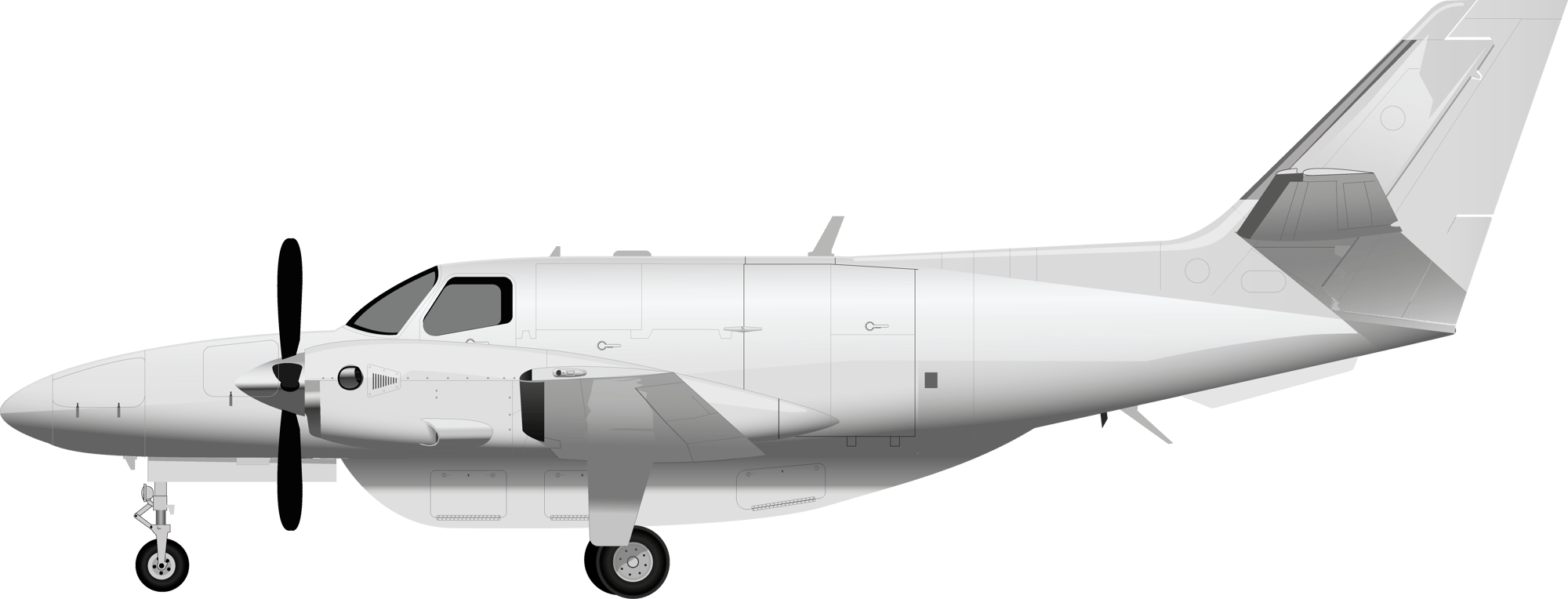
Top Down Cutaway
Main Deck
Side Cargo Door
Width: 47 in
Height: 46 in
Max Payload
Cubic ft: 196
Weight: 3,085

Range & Routes
Airport Requirements
Runway Requirements
Crew
KEY AIRCRAFT SPECIFICATIONS
Cessna 406 Caravan II Specs
Length
56 feet
Wingspan
54 feet
Maximum Takeoff Weight
28,600 pounds
Maximum Payload
Approximately 4,500 pounds
Range
Approximately 2,000 miles with a full payload including crew, fuel, and cargo
Cargo Volume
Approximately 449 cubic feet
Cruise Speed
530 miles per hour
Engines
Typically equipped with two General Electric CF700-2D engines
McDonnell Douglas DC-8 71 - 73F

Top Down Cutaway
Main Deck (Top)
Lower Deck (Bottom)
Max Payload
Cubic ft: 10,400
Weight: 88,400
Side Cargo Doors
Main Deck
Width: 137 in
Height: 86 in
Lower Deck Fore
& Aft
Width: 36 in
Height: 44 in

Range & Routes
Airport Requirements
Runway Requirements
Crew
KEY AIRCRAFT SPECIFICATIONS
McDonnell Douglas DC-8 71 - 73F Specs
Length
151 feet
Wingspan
142 feet
Maximum Takeoff Weight
355,000 pounds
Maximum Payload
Approximately 88,400 pounds
Range
Approximately 6,000 miles with a full payload including crew, fuel, and cargo
Cargo Volume
Approximately 10,400 cubic feet
Cruise Speed
560 miles per hour
Engines
Typically equipped with four Pratt & Whitney CFM56 turbofan engines
Convair CV-580

Top Down Cutaway
Main Deck
Side Cargo Door
Width: 115 in
Height: 70 in
Max Payload
Cubic Ft: 2,350
Weight: 15,400

Range & Routes
Airport Requirements
Runway Requirements
Crew
KEY AIRCRAFT SPECIFICATIONS
Convair CV-580 Specs
Length
82 feet
Wingspan
92 feet
Maximum Takeoff Weight
56,000 pounds
Maximum Payload
Approximately 15,400 pounds
Range
1,800 miles with a full payload
Cargo Volume
Approximately 2,350 cubic feet
Cruise Speed
340 miles per hour
Engines
Typically equipped Allison 501 D13D/H turboprop engines with four-blade propellers
Antonov An-26

Top Down Cutaway
Main Deck
Cargo Cross Section
Main Deck
Width: 74 in
Height: 55 in
Max Payload
Cubic ft: 1,348
Weight: 12,100
Rear Cargo Door
Width: 86 in
Height: 64 in

Range & Routes
Airport Requirements
Runway Requirements
Crew
KEY AIRCRAFT SPECIFICATIONS
Antonov An-26 Specs
Length
78 feet
Wingspan
96 feet
Maximum Takeoff Weight
52,900 pounds
Maximum Payload
Approximately 12,100 pounds
Range
680 miles with a full payload
Cargo Volume
Approximately 1,348 cubic feet
Cruise Speed
270 miles per hour
Engines
Typically equipped with two Progress AI-24VT turboprop engines with four-blade propellers
Shorts SD 360

Top Down Cutaway
Main Deck
Side Cargo Doors
Width: 55 in
Height: 65 in
Max Payload
Cubic ft: 922
Weight: 3,200

Range & Routes
Airport Requirements
Runway Requirements
Crew
KEY AIRCRAFT SPECIFICATIONS
Shorts SD 360 Specs
Length
71 feet
Wingspan
75 feet
Maximum Takeoff Weight
12,300 pounds
Maximum Payload
Approximately 3,200 pounds
Range
990 miles with a full payload
Cargo Volume
Approximately 922 cubic feet
Cruise Speed
210 miles per hour
Engines
Typically equipped with two Pratt & Whitney Canada PT6A-65AR turboprop engines
Fairchild Metro II

Top Down Cutaway
Main Deck
Side Cargo Door
Width: 53 in
Height: 51 in
Max Payload
Cubic ft: 88
Weight: 2,755

Range & Routes
Airport Requirements
Runway Requirements
Crew
KEY AIRCRAFT SPECIFICATIONS
Fairchild Metro II Specs
Length
59 feet
Wingspan
57 feet
Maximum Takeoff Weight
16,000 pounds
Maximum Payload
Approximately 2,755 pounds
Range
680 miles with a full payload
Cargo Volume
Approximately 400 cubic feet
Cruise Speed
320 miles per hour
Engines
Typically equipped with two Garrett AiResearch TPE-331 turboprop engines
Boeing 737-400F
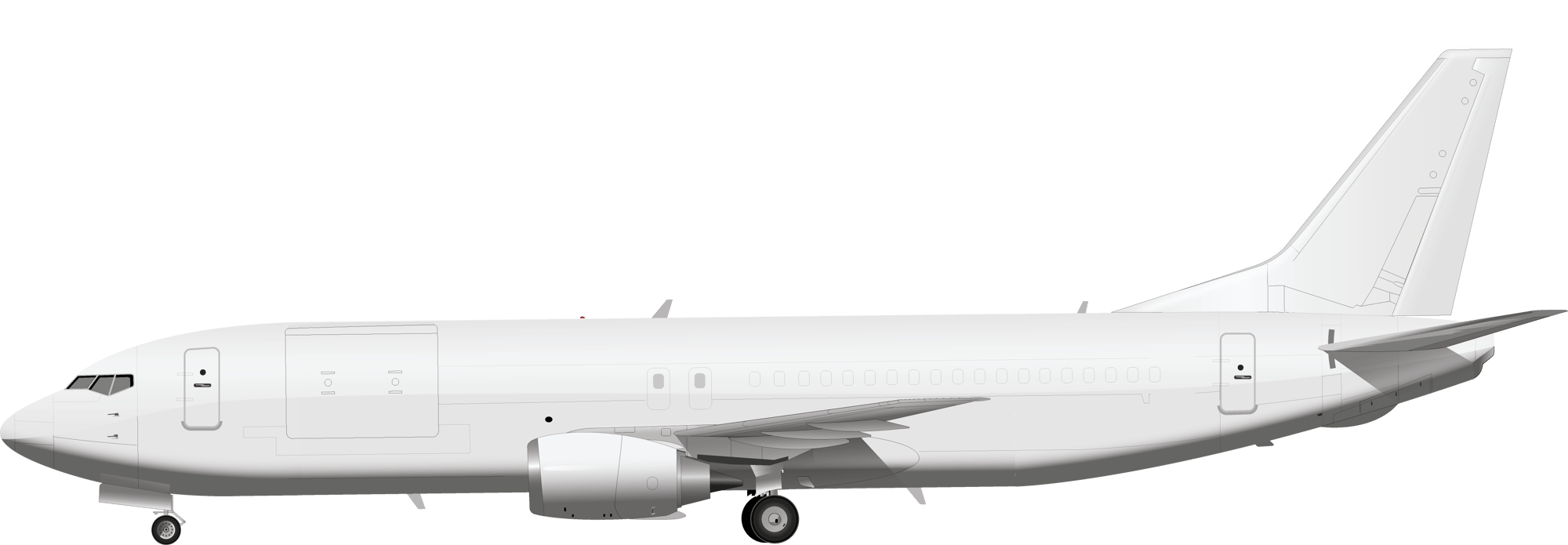
Top Down Cutaway
Main Deck (Top)
Lower Deck (Bottom)
Side Cargo Door
Main Deck
Width: 139 in
Height: 81 in
Lower Deck Fore
Width: 44 in
Height: 33 in
Max Payload
Cubic ft: 4,600
Weight: 42,300

Range & Routes
Airport Requirements
Runway Requirements
Crew
KEY AIRCRAFT SPECIFICATIONS
Boeing 737-400F Specs
Length
120 feet
Wingspan
95 feet
Maximum Takeoff Weight
148,000 pounds
Maximum Payload
Approximately 45,000 pounds
Range
Approximately 2,300 miles with a full payload including crew, fuel, and cargo
Cargo Volume
Approximately 5,600 cubic feet
Cruise Speed
450 miles per hour
Engines
Typically equipped with two CFM International CFM56 turbofan engines
Antonov An-12

Top Down Cutaway
Main Deck
Cargo Cross Section
Main Deck
Width: 135 in
Height: 80 in
Max Payload
Cubic feet: 3,180
Weight: 44,000
Rear Cargo Door
Width: 117 in
Height: 116 in

Range & Routes
Airport Requirements
Runway Requirements
Crew
KEY AIRCRAFT SPECIFICATIONS
Antonov An-12 Specs
Length
109 feet
Wingspan
125 feet
Maximum Takeoff Weight
134,500 pounds
Maximum Payload
Approximately 44,000 pounds
Range
Approximately 2,200 miles with a full payload including crew, fuel, and cargo
Cargo Volume
Approximately 3,180 cubic feet
Cruise Speed
350 miles per hour
Engines
Typically equipped with 4 Ivchenko AI-20L or AI-20M turboprop engines
McDonnell Douglas DC-9 15F

Top Down Cutaway
Main Deck (Top)
Lower Deck (Bottom)
Max Payload
Cubic Feet: 4,562
Weight: 22,930
Side Cargo Door
Main Deck
Width: 136 in
Height: 81 in
Lower Deck Fore
& Aft
Width: 36 in
Height: 44 in

Range & Routes
Airport Requirements
Runway Requirements
Crew
KEY AIRCRAFT SPECIFICATIONS
McDonnell Douglas DC-9 15F Specs
Length
104 feet
Wingspan
90 feet
Maximum Takeoff Weight
90,000 pounds
Maximum Payload
Approximately 22,930 pounds
Range
Approximately 1,650 miles with a full payload including crew, fuel, and cargo
Cargo Volume
Approximately 4,562 cubic feet
Cruise Speed
550 miles per hour
Engines
Typically equipped with two Pratt & Whitney JT8D turbofan engines
Fairchild Metro III

Top Down Cutaway
Main Deck
Side Cargo Door
Width: 53 in
Height: 51 in
Max Payload
Cubic feet: 385
Weight: 4,410

Range & Routes
Airport Requirements
Runway Requirements
Crew
KEY AIRCRAFT SPECIFICATIONS
Fairchild Metro III Specs
Length
59 feet
Wingspan
57 feet
Maximum Takeoff Weight
16,000 pounds
Maximum Payload
Approximately 4,100 pounds
Range
680 miles with a full payload
Cargo Volume
Approximately 420 cubic feet
Cruise Speed
320 miles per hour
Engines
Typically equipped with two Garrett AiResearch TPE-331 turboprop engines
Embraer EMB-110 Bandeirante

Top Down Cutaway
Main Deck
Side Cargo Door
Width: 75 in
Height: 55 in
Max Payload
Cubic Feet: 490
Weight: 3,500

Range & Routes
Airport Requirements
Runway Requirements
Crew
KEY AIRCRAFT SPECIFICATIONS
Embraer EMB-110 Bandeirante Specs
Length
50 feet
Wingspan
50 feet
Maximum Takeoff Weight
13,000 pounds
Maximum Payload
Approximately 3,500 pounds
Range
1,200 miles with a full payload
Cargo Volume
Approximately 490 cubic feet
Cruise Speed
255 miles per hour
Engines
Typically equipped with two Pratt & Whitney Canada PT6A-34 turboprop engines
Piper PA-31
A freighter adaptation of the well-proven Navajo, this twin-engine aircraft excels at fast, point-to-point deliveries into small airports and remote airstrips. Operators value its reliability, low-speed handling, and solid performance on rough surfaces.
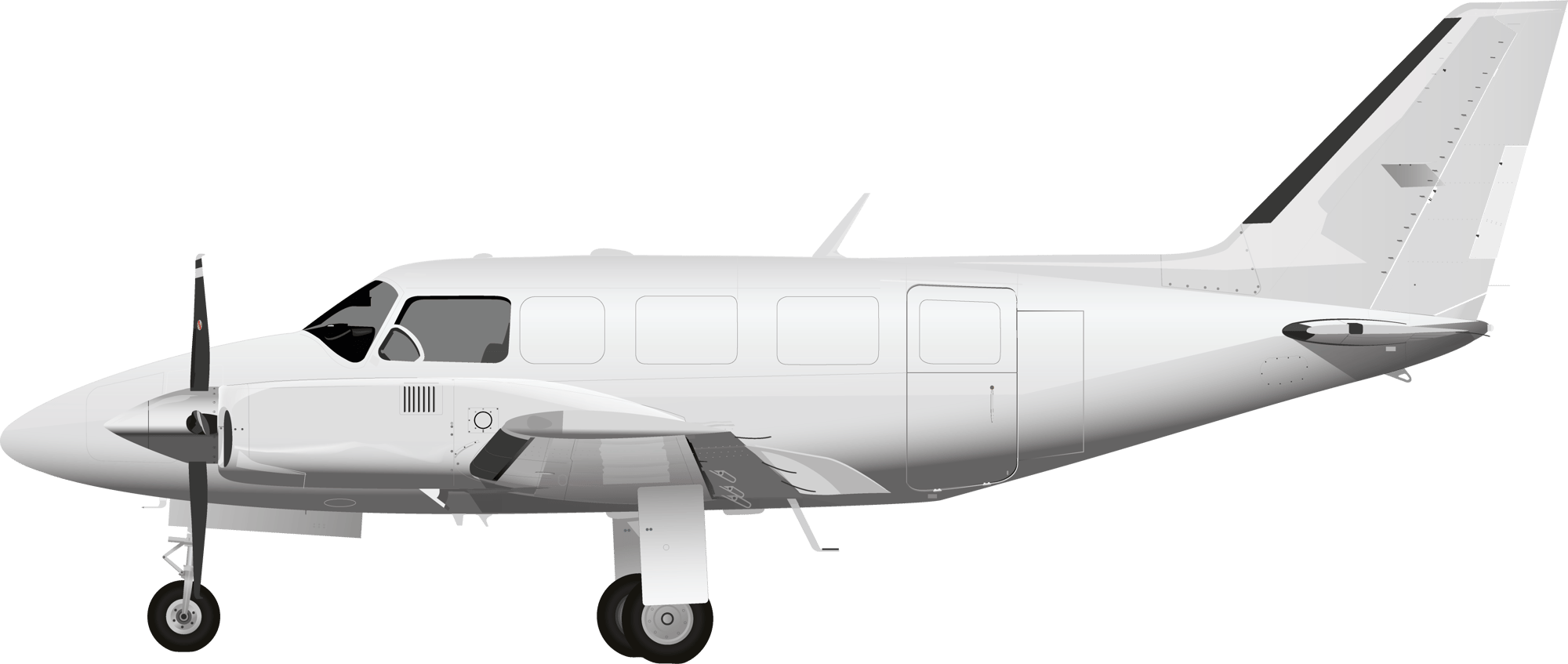
Top Down Cutaway
Main Deck
Side Cargo Door
Width: 40 in
Height: 40 in
Side Cargo Door
Door 1
Width: 26 in
Height: 40 in
Width: 14 in
Height: 17.7 in
Max Payload
Cubic feet: 1,348
Weight: 1,200

Range & Routes
Airport Requirements
Taxiway Width: Standard airports should offer at least 80 ft edge-to-edge, though the aircraft can negotiate rural taxiways as narrow as 40–50 ft thanks to responsive handling.
Parking Apron Space: A stand of 70 ft × 70 ft clears the wings and leaves room for fueling and ground-service vehicles.
Ground Handling: Light freight is typically loaded by hand; the steerable nose-wheel makes use of a tug optional.
Fueling: Mobile trucks refuel the aircraft with up to 190 gal, adjusted for payload and trip length.
Power and Air Support: A ground-power unit is not mandatory, but can be useful in cold weather, during frequent turnarounds, or for maintenance checks.
Runway Requirements
Takeoff Runway Length: About 1,500 ft at maximum payload; shorter distances are possible with lighter loads. Hot-and-high conditions (fields above 8,000 ft) or strong winds will increase the requirement.
Landing Runway Length: Roughly 1,300 ft fully loaded, with even less needed when lightly laden. Wet, icy, or unpaved surfaces will lengthen stopping distance.
Crew
The PA-31 can be operated by one pilot. Carriers may assign additional loadmasters or helpers to oversee cargo and coordinate precise door-to-door delivery.
KEY AIRCRAFT SPECIFICATIONS
Piper PA-31 Specs
Length
33 feet
Wingspan
41 feet
Maximum Takeoff Weight
6,500 pounds
Maximum Payload
Approximately 1,200 pounds
Range
1,165 miles with a full payload
Cargo Volume
Approximately 140 cubic feet
Cruise Speed
240 miles per hour
Engines
Typically equipped with two Lycoming TIO-540-A turbocharged piston engines
Cost of Urgent Shipping
Which of our specialized shipping services best fits your needs?
Blog and Resource Center
How AirFreight.com Solved a PGA Tour Shipping Emergency
Learn how AirFreight.com located a lost shipment and helped save the PGA Golf Tour.
How AirFreight.com Saved The Farm By Solving A Major Shipping Delay
Learn how we saved a Montana-based artisanal farm thousands of dollars by expediting a shipment of perishable goods.
Expedited Shipping Vendor Comparison
We’ve done the research for you. This vendor comparison sheet breaks down how AirFreight.com stacks up against the competition.



